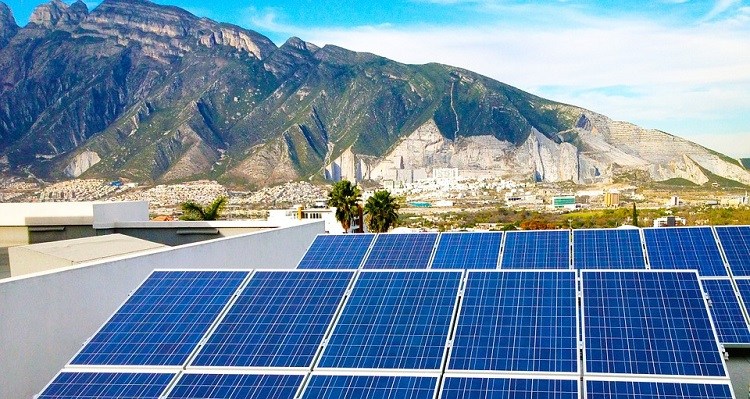The planet urgently needs sustainable models of energy production. Among the sectors that offer new perspectives, is that of solar energy. A recent study, conducted in Switzerland, ensures that the installation of photovoltaic panels in high mountain areas with snow allows to increase the production of electricity in winter and thus cope better with the increase in demand in the cold months.
Authors indicate that some of the factors that favor the generation of solar energy in the mountain are the greater exposure to solar radiation with respect to low altitude areas and the phenomenon of reflection of the rays in the snow (albedo). However, aspects such as the possible rejection of local populations to the installation of adequate infrastructures raise doubts about the feasibility of this scenario.
The study, published in the journal PNAS, explains that in the areas of half-latitudes the use of solar energy changes according to the period of the year. In summer the production is high, while in winter it is reduced. This limitation clashes with the demand of users, which increases in the colder months.
Some features of high mountain areas allow better use of solar energy in the winter months, continue the researchers responsible for this scientific article, from the Ecole Polytechnique Federale de Lausanne and the Institute for Snow and Avalanche Research in Davos (Switzerland).
One of them is that the density of the atmosphere is lower than in low altitude areas, and thus solar radiation is absorbed less. In addition, weather phenomena such as fog and low clouds are usually absent in winter. Another fundamental characteristic of high areas such as the alpine peaks is the presence of snow, which reflects the sun’s rays.
The authors stress that in order to take advantage of these factors it is key to correctly study the inclination of the photovoltaic panels. That implies that they are installed in a more vertical position than usual, they specify. The conclusion reached is that the combination of all these aspects means that in higher altitude regions it is possible to generate the same amount of annual solar energy as in low altitude regions, but with higher productivity in winter.
When comparing the area needed in Switzerland to meet the same demand (12 terawatts in a year) in both cases, the one needed in high mountain turns out to be up to 10 square kilometers -which corresponds to 1,000 football fields- smaller.
“Photovoltaic energy is a key source for future electricity production,” says Annelen Kahl, co-author of the study. “That’s why it’s important not only to produce it more efficiently but also at the right time,” he adds. From a technical point of view, it specifies, the viability of this approach depends on the characteristics of each place in which it is intended to be implemented.
Many areas of the Alps, as an example, already have infrastructures such as roads and buildings “that can work as a base to apply solar panels”. Hydroelectric power plants, he adds, represent an ideal base, “because the power grid connection already exists.”
The researcher believes that you can think both large solar parks and small facilities for self-consumption. In particular, it considers “especially attractive” the possibility that local communities self-finance the production and storage of electricity to achieve energy independence.
Ricardo Luis Guerrero, from the University of La Laguna, assesses the study proposal as “technically correct” for some countries with high altitude and areas of perpetual snow, although he does not believe that it is a “generalizable solution”. Among the regions where the feasibility of this approach could be studied, includes the Pyrenees. “In many areas of this chain, there is much more radiation than in the environment. It could even help strengthen the interconnection between France and Spain, “he argues.
Among the obstacles to the implementation of projects of this type, Guerrero indicates the possible weakness of electricity networks in theoretically adequate areas, such as Tibet or Los Andes, due to the scarcity of the population. “It would require mega plants for economies of scale to make them profitable,” he says. A solar park under construction at 4,200 meters in the province of Jujuy (Argentina) is an example of the type of installation that would be needed to make production viable in high mountain areas like these, he adds.
But the main problem, in his opinion, would be the acceptance of the population of the consequent environmental impact. “I can not imagine anyone accepting to cover with photovoltaic our Las Cañadas del Teide park (Tenerife), where we only have 30 days of clouds per year,” he says ironically.
For his part, Kahl is aware of this aspect. “It is important to raise awareness about the advantages of these facilities and provide good information on the safety and low visual impact of photovoltaic panels with respect to wind turbines or high voltage transmission lines,” he says. In his opinion, “in combination with a hydroelectric plant or a ski resort, the solar panels would not make a big difference.”
The researcher tells that she is studying, together with other colleagues, the market value of the electricity produced in the mountain with the solar panels. At the moment, the results obtained are not definitive, but they are promising, he says. “We believe that the price will tend to fall, due to higher production at times of higher demand,” he says.
The author adds that there will also be less need to import energy from other countries. However, qualifies, we must consider the cost of the installation (which increases if you can not count on previous infrastructures) and the capacity of the electrical network with which it could be connected.
In short, Kahl believes that his study shows how “from a physical point of view, resources are better in the mountains”, but that more studies have to be done to find out the viability of this perspective. “We hope that our idea is taken into account when planning the energy transition of our countries,” he concludes.
Last October, the Spanish Congress validated a Royal Decree Law that eliminates administrative restrictions and costs that limited the possibility of taking advantage of the energy generated through photovoltaic panels (in particular the one known as “sun tax”, approved in 2015) and opens new perspectives to favor the energy transition towards renewable energies.
“The new Royal Decree-Law greatly simplifies the rules and opens the field of community production. It is ideal for owner buildings, “says Ricardo Luis Guerrero of the University of La Laguna. In addition, the standard favors the sale of excess production to the electricity grid. “It can allow a revolution”, values the teacher.
The Institute for Energy Diversification and Saving (IDAE) explains that the simplest form of self-consumption is an installation that covers the energy needs of common areas such as elevators or the lighting of stairs, portals and garages. Such panels are frequently being more utilised within the New Zealand construction industry, with panels being fitted to large-scale during the construction of educational facilities.
You can also implement facilities that supply homes, owned by the neighborhood community, which would be responsible for billing each of them. A further option is a flexible installation that provides power only to neighbors who have decided to connect but allows others to follow through later.








Add Comment